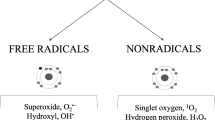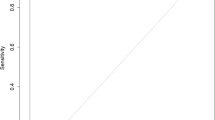Abstract
The pathogenesis of diseases of the gastrointestinal tract in horses is accompanied by inflammation and oxidative stress and may be caused by a lack of nitric oxide, which controls various signaling pathways in the body. The level of nitrites, which are metabolites of nitric oxide in horses with various intestinal diseases, has been evaluated in blood serum at 3.60 ± 3.02 μM and 8.3 ± 6.0 μM in horses at ages of 7–26 years and 1–5 years, respectively. A sharp reduction in the nitrite concentrations was observed in all horses with intestinal diseases (3.39 ± 2.85 μM), especially in horses with tympanitic caecum (0.6 ± 0.4 μM) and obstruction of the colon (0.81 ± 0.5 μM).







Similar content being viewed by others

REFERENCES
P. C. Barko, M. A. McMichael, K. S. Swanson, and D. A. Williams, J. Vet. Intern. Med. 32, 9 (2018).
N. D. Cohen, Equine Vet. Educ. 14 (4), 212 (2002).
E. Lorenz, Curr. Pharmaceut. Des. 12 (32), 4185 (2006).
H. Hug, M. H. Mohajeri, and G. La Fata, Nutrients 10, 203 (2018).
J. Vermeiren, T. Van de Wiele, W. Verstraete, et al., J. Biomed. Biotechnol. 2009, 284718 (2009).
J. O. Lundberg and E. Weitzberg, Gut 62 (4), 616 (2013).
F. A. Uzal and S. S. Diab, Vet. Clin. North Am. Equine Pract. 31, 337 (2015).
8. D. Rachmilewitz, J. S. Stamler, D. Bachwich, et al., Gut 36 (5), 718 (1995).
M. Herulf, B. Svenungsson, A. Lagergren, et al., J. Infect. Dis. 180 (2), 542 (1999).
N. K. Chokshi, Y. S. Guner, C. J. Hunter, et al., Semin. Perinatol. 32 (2), 92 (2008).
R. E. Malmstrom, H. Bjorne, A. Oldner, et al., Shock 18 (5), 456 (2002).
M. B. Grisham, K. P. Pavlick, F. S. Laroux, et al., J. Investig. Med. 50 (4), 272 (2002).
D. M. McCafferty, J. S. Mudgett, M. G. Swain, and P. Kubes, Gastroenterology 112 (3), 1022 (1997).
H. M. M. Ibrahim, J. Equine Vet. Sci. 34 (10), 1205 (2014).
N. Gamper and L. Ooi, Antioxid. Redox Signaling 22 (6), 486 (2015).
J. S. Stamler, O. Jaraki, J. Osborne, et al., Proc. Natl. Acad. Sci. U. S. A. 89 (16), 7674 (1992).
D. T. Hess, A. Matsumoto, S.-O. Kim, et al., Nature Rev. Mol. Cell Biol. 6, 150 (2005).
A. F. Vanin, V. A. Serezhenkov, V. D. Mikoyan, and M. V. Genkin, Nitric Oxide 2 (4), 224 (1998).
V. P. Mokh, A. P. Poltorakov, V. A. Serezhenkov, and A. F. Vanin, Nitric Oxide 22 (4), 266 (2010).
V. A. Serezhenkov, S. M. Borunova, M. I. Kuznetsova, and N. A. Tkachev, Dezinfekt. Antisept. 5 (1), 50 (2014).).
A. Gow and J. Stamler, Nature 391 (6663), 169 (1998).
S. A. Rocks, C. A. Davies, S. L. Hicks, et al., Free Radic. Biol. Med. 39 (7), 937 (2005).
P. H. MacArthur, S. Shiva, and M. T. Gladwin, J. Chromatogr. 851, 93 (2007).
D. Tsikas, J. Chromatogr. B. Analyt. Technol. Biomed. Life Sci. 851, 51 (2007).
M. H. Mirza, J. L. Oliver, T. L. Seahorn, et al., Can. J. Vet. Res. 63 (4), 230 (1999).
N. Galvin, H. Dillon, and F. McGovern, Irish Vet. J. 57 (8), 467 (2004).
M. H. Mirza, T. L. Seahorn, J. L. Oliver, et al., Can. J. Vet. Res. 69, 106 (2005).
D. Tsikas, Anal. Biochem. 379 (2), 139 (2008).
V. D. Mikoyan, L. N. Kubrina, V. A. Serezhenkov, et al., Biochim. Biophys. Acta 1336 (2), 225 (1997).
S. K. Jackson, M. P. Thomas, S. Smith, et al., Faraday Discuss. 126, 103 (2004)
G. Dijkstra, H. van Goor, P. L. Jansen, and H. Moshage, Curr. Opin. Invest. Drugs 5 (5), 529 (2004).
M. J. Rand and C. G. Li, Annu. Rev. Physiol. 57, 659 (1995).
O. Dietz and B. Huskamp, Handbuch Pferdepraxis, 3rd ed. (Enke, 2006).
M. Kovach, Colic Horses. Causes. Diagnosis. Treatment (Royal Publ. House, 2010).
N. A. White and B. Edwards, Handbook of Equine Colic (Butterworth-Heinemann, Oxford, 2001).
H. Bult, G. E. Boeckxstaens, P. A. Pelckmans, et al., Nature 345, 346 (1990).
N. E. Robinson, Current Therapy in Equine Medicine, 5th ed. (Saunders, 2003).
C. A. Reinders, D. Jonkers, E. A. Janson, et al., Scand. J. Gastroenterol. 42 (10), 1151 (2007).
F. Dalloz, V. Maupoil, S. Lecour, et al., Mol. Cell. Biochem. 177, 193 (1997).
C. Nathan and M. U. Shiloh, Proc. Natl. Acad. Sci. U. S. A. 97 (16), 8841 (2000).
I. Bjarnason, J. Hayllar, A. J. MacPherson, and A. S. Russell, Gastroenterology 104, 832 (1993).
R. P. Mason and P. D. Josephy, J. Inorg. Biochem. 24 (2), 161 (1985).
B. Whittle, Expert Opin. Investig. Drugs 14 (11), 1347 (2005).
A. Slivka, R. Chuttani, D. L. Carr-Locke, et al., J. Clin. Invest. 94 (5), 1792 (1994).
S. Borniquel, E. A. Jansson, M. P. Cole, et al., Free Radic. Biol. Med. 48, 499 (2010).
J. M. Lee, J. Y. Lim, Y. Kim, et al., Exp. Ther. Med. 12 (2), 573 (2016).
A. F. Vanin, Nitric Oxide 54, 15 (2016).
A. F. Vanin, Cell. Biochem. Biophys. 77 (4), 279 (2019).
J. R. Hickok, D. Vasudevan, G. R. Thatcher, et al., Antioxid. Redox Signal. 17 (7), 962 (2012).
H. Ischiropoulos, Arch. Biochem. Biophys. 356 (1), 1 (1998).
D. Tsikas and J. C. Frolich, Circ. Res. 90, 39 (2002).
V. Y. Titov, A. M. Dolgorukova, V. G. Vertiprakhov, et al., Bull. Exp. Biol. Med. 168, 321 (2020).
E. D. Lamprecht and Williams, C. A., Oxid. Med. Cell. Longev. 2012, 1 (2012).
G. T. Mukosera, T. Liu, A. S. Ahmed, et al., Nitric Oxide 79, 57 (2018).
Author information
Authors and Affiliations
Corresponding author
Ethics declarations
Conflict of interests. The authors declare that they have no conflicts of interest.Statement on the welfare of animals. All applicable international, national, and/or institutional guidelines for the care and use of animals were followed.
Additional information
Translated by A. Levina
Abbreviations: DNIC—dinitrosyl iron complexes; ESR—electronic spin resonance; MGD—N-methyl-D,L-glucaminedithiocarbamate; MNIC—mononitrosyl iron complexes.
Rights and permissions
About this article
Cite this article
Serezhenkov, V.A., Tkachev, N.A., Artyushina, Z.S. et al. Reduced Nitric Oxide Bioavailability in Horses with Colic: Evaluation by ESR Spectroscopy. BIOPHYSICS 65, 869–875 (2020). https://doi.org/10.1134/S0006350920050176
Received:
Revised:
Accepted:
Published:
Issue Date:
DOI: https://doi.org/10.1134/S0006350920050176



